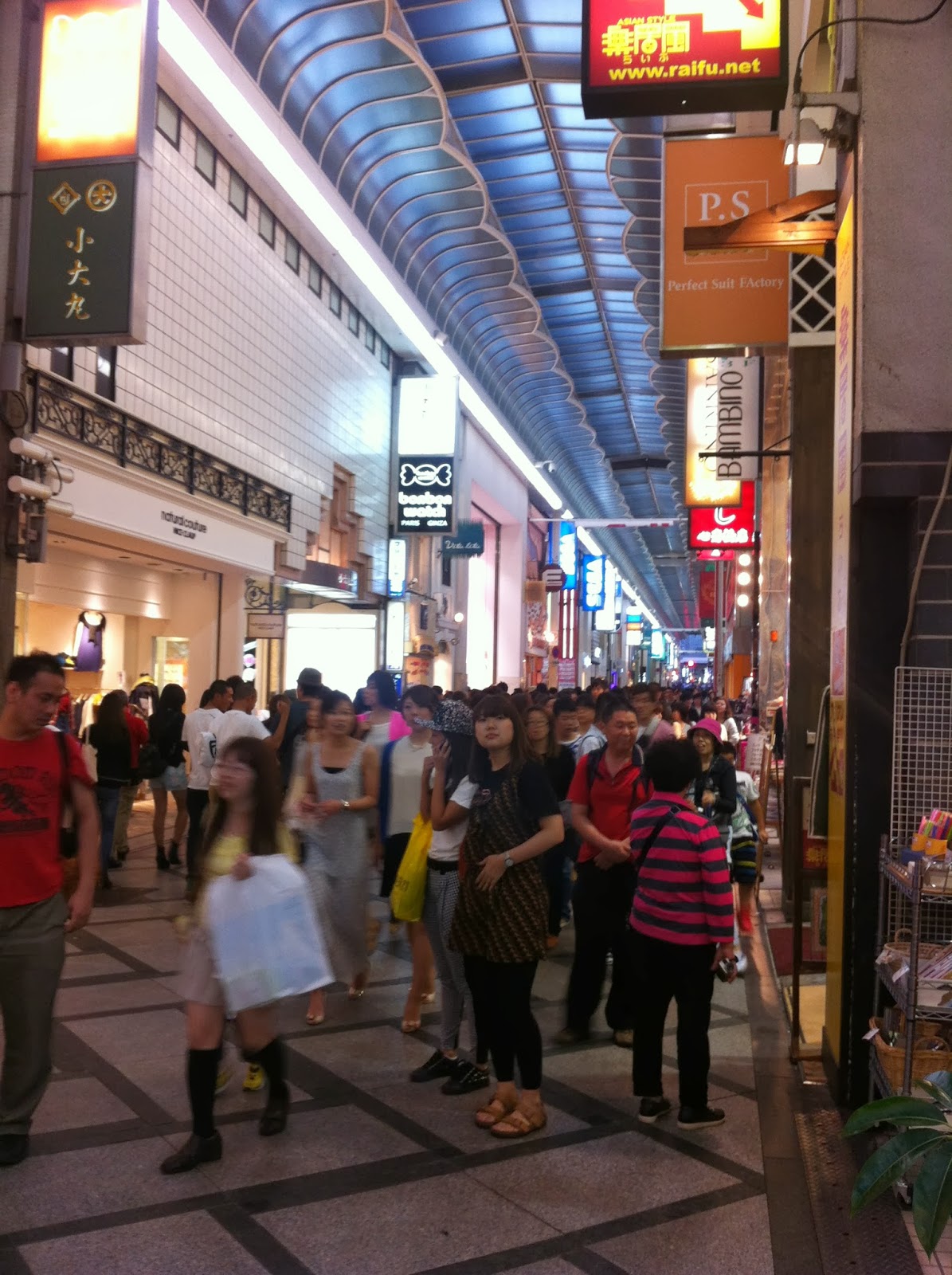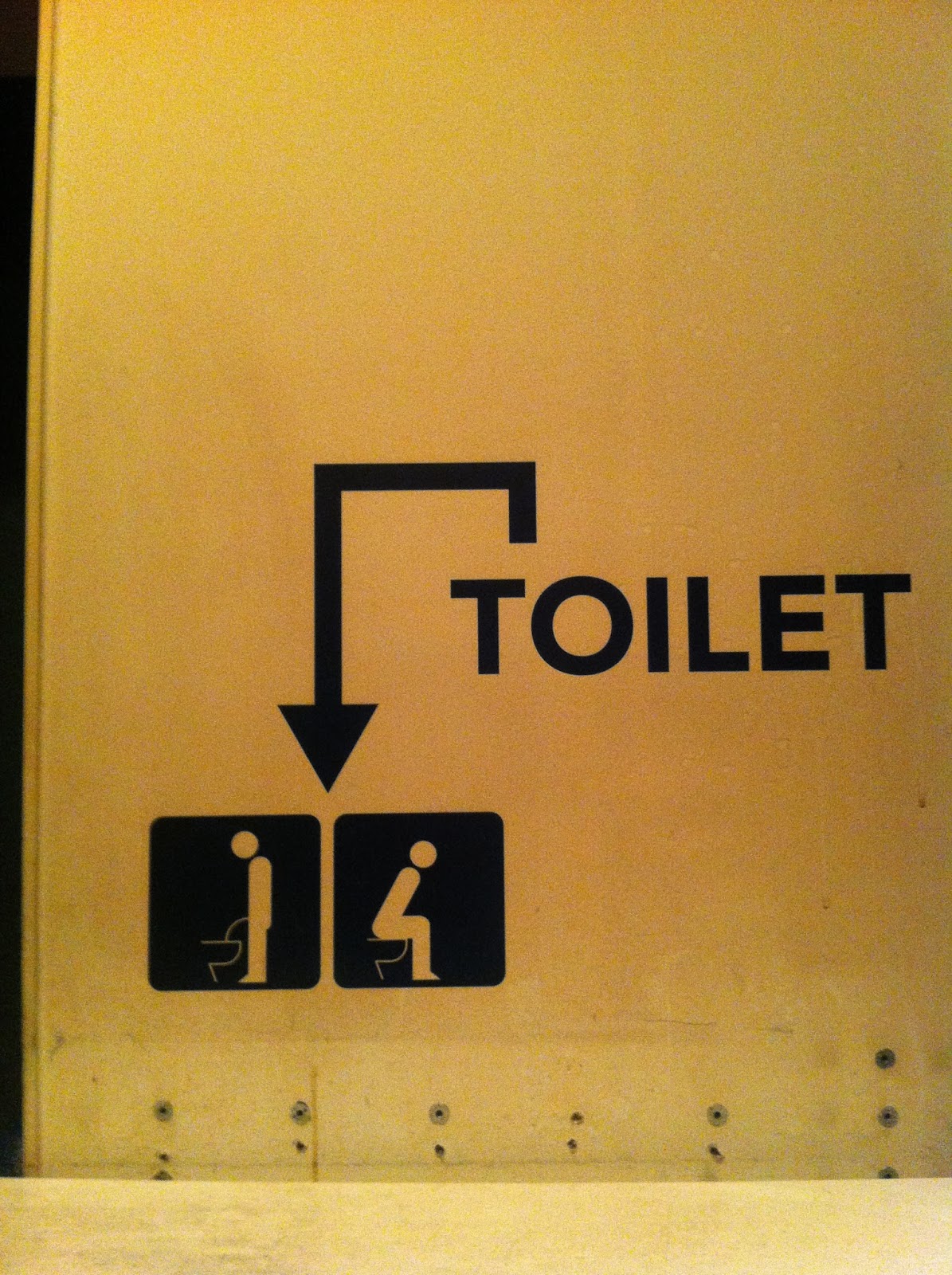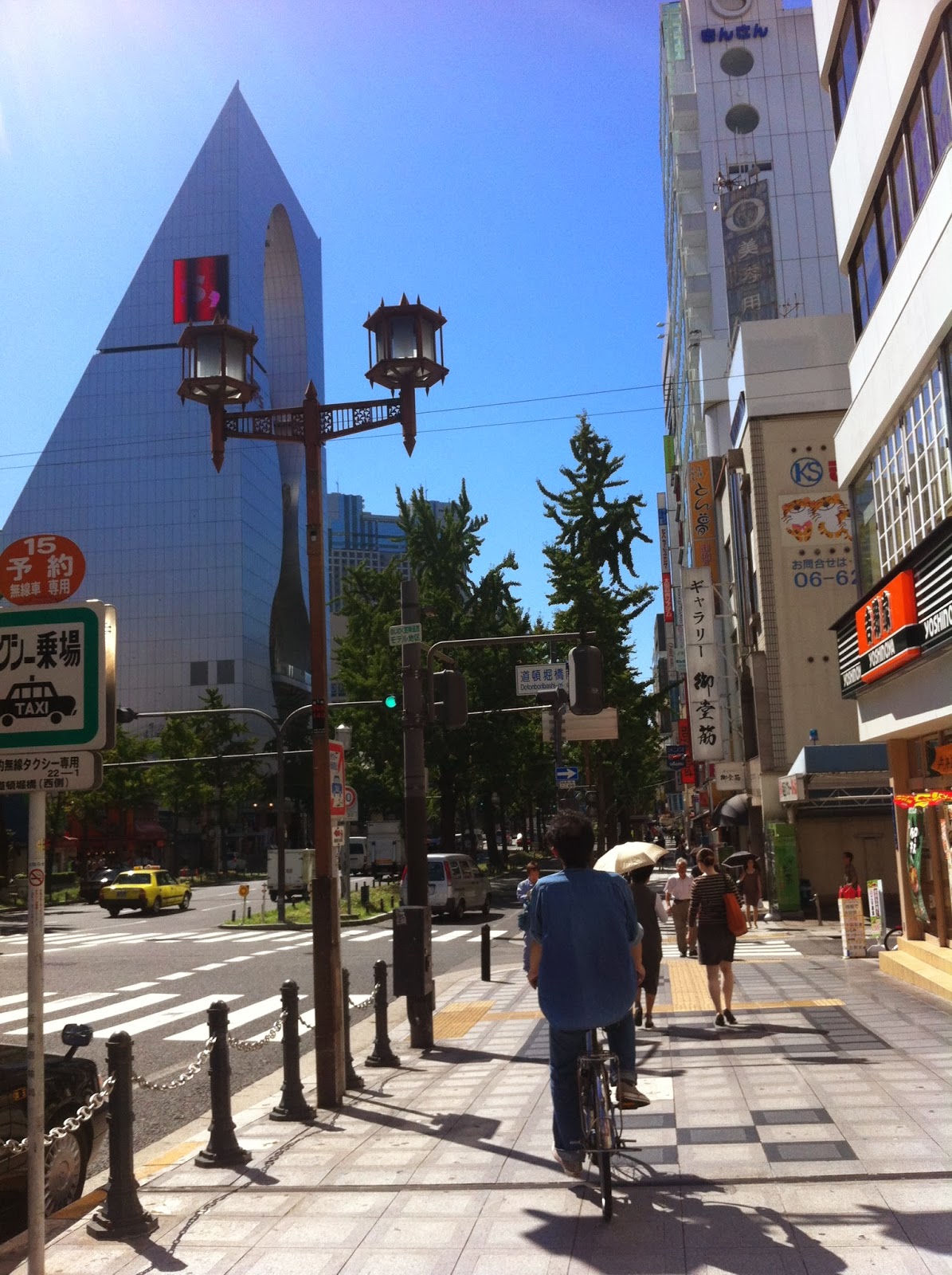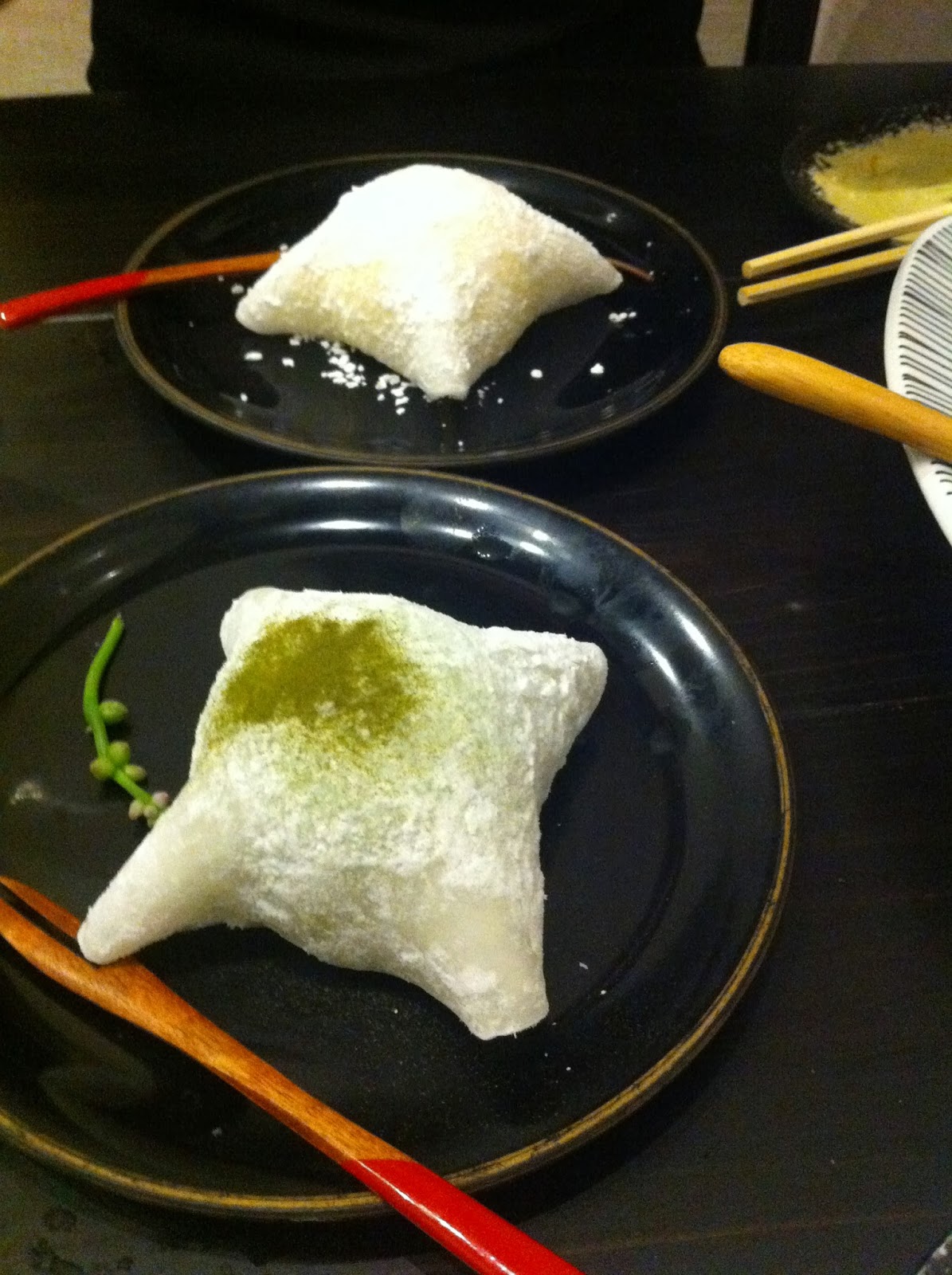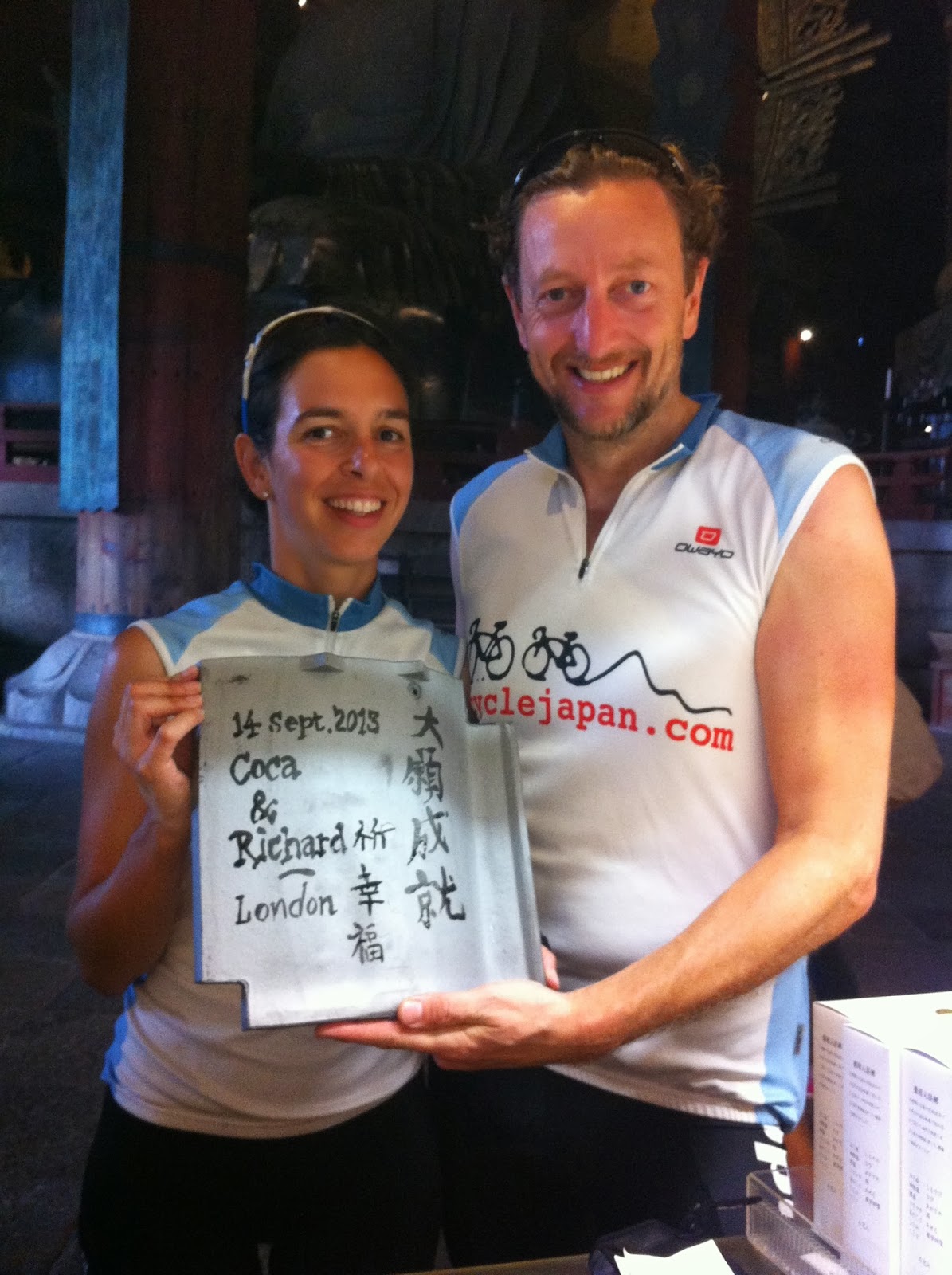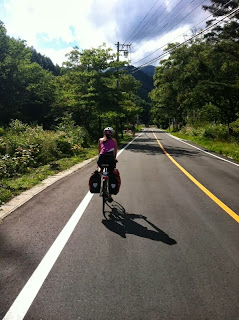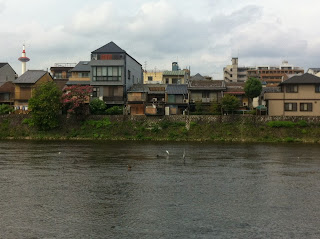 |
| Photo courtesy of Masahisa Himi , Japanese artist and photographer |
Thursday 19 September 2013
Wednesday 18 September 2013
Day 25- Ise to Fuji
Having finally accepted that this had become less of a cycling tour and more a tour with cycling (I should maybe get the tour shirts over-printed with the bits we did by train for accuracy), we boarded the Rapid at Toba, carrying panniers and bike bags over our shoulders, heading for Nagoya.
At Nagoya station, huge modern skyscrapers were visible from the platform as we changed onto the famous Shinkansen 'bullet train'. This super-fast line took us on to Shin-Fuji, the Fuji stop.
We had a competition as to which one of us would see Mount Fuji first (Coca took it to the extreme of moving further up the train). Fuji is renowned for hiding its 3776m peak beneath clouds during much of the year, so we were by no means certain either would see it.
Clouds adopted Fuji-shaped tops in the distance from as far back as Toyohashi, about 150km from the mountain
 |
| Bullet Train |
Fuji descent

We reassembled the bikes in the car park at stage 5, 2400m and above the clouds. It's possible to reach stage 6, but on foot, not on road bikes. We met a couple of researchers from Norwich Uni who had dodged the barriers at stage 6 and climbed to the summit, sleeping out on Fuji overnight. No bears here, but very cold. They looked tired but elated, and one eyed our bikes jealously, "I knew I should have brought my mountain bike!"
We layered-up: long sleeves over cycle jerseys, rain jackets over everything.
Goodbyes as the climbers waited for their bus down, and we descended into the cloud. A series of hairpins slowed progress until we dropped back into the late sunshine, watching the sky go orange and then red.
In twilight we hit the main road, downhill and much straighter for longer. Smooth tarmac and hardly any passing traffic encouraged early evening recklessness and we recorded speeds of 41/42mph through streaming eyes. Local speed limit noted as 40kmh but no speed traps thankfully.
A full moon lit our way as we skirted the line of hills between mountain and sea, and we passed through the suburbs of Fuji town after dark. A lucky meeting with a local walking his dog provided us with a route to the Shinkansen station. Typical of the unexpected generosity of Japanese people, he reappeared some time later at the station in his car as we were dismantling our bikes, worried we might have misunderstood his directions and lost our way. We thanked him again, waved him off, smiling, and boarded the bullet train to Tokyo.
.
Tuesday 17 September 2013
Day 24 - Osaka to Ise
Arrived at Ise on the Kasai local train
Naiku and Geku are among the most important and holy of Shinto religion's shrines, housing it's most venerated deities, and this area has been subject to pilgrimage - called oise mairi - for many centuries. The Edo period, from 1603-1868, saw a dramatic rise in use of the pilgrim trail, with many ryokan and merchants establishing themselves along the route. Their traces line the roads, some still in use today.
Naiku, the Grand Shrine, was first established around 2000 years ago, enshrining the sun goddess, Amaterasu. She is symbolised in a mirror which sits deep within the holiest central shrine, inaccessible to all but the highest Shinto priests.
Naiku Seidan, the main building is also an example of Japan's oldest architectural style- yuiitsu shinmei zukuri.
Geku was established much later- only 1500 years ago. Here the deity of food and industriousness was set to work preparing packed lunches (bento boxes?) for Amaterasu. The deities of wind and rain are also enshrined here. We felt like we'd already got to know them pretty well.
We caught the train to Ise - Ujiyamada station which sits close to Geku temple and cycled the 12km over the hill to Naiku temple.
In the afternoon light, golden dragonflies flitting through carefully sculpted trees in the gardens approaching Naiku shrine. You cross ceremonial bridges and pass through Torii gateways on your way deeper into sacred space.
Preparing for the ceremony to move the deity from old shrine to new, a wide deck has been built below the enclosure. However, this is in woodland, so in order to achieve this, scaffolding has been carefully erected over the plants and bushes, at about 2m high, and a timber deck then laid over the scaffold, carefully cut around the trees. The larger trees nearest the shrine have been wrapped at their bases with bamboo tied with woven fibre rope to protect them. The result is a piece of installation art, minimal but stunning.
The new shrine enclosure stands slightly lower than the old, clean, smooth-edged wood crafted and fixed with mortice and tenon joints, dowels and wedges.
Small cafe restaurant in a short parade with tanks of water filled with horny lobsters (in Japanese, Ise-ebi, named after the area), oysters, 'turban shells', scallops and clams at Toba station where we met and Kazumitsu and Hisayo Masueani who waved us into the shop from an open doorway. "Hello! Please come in!", down from Suzuka "for the day to enjoy the seafood. This is the best shellfish restaurant in Toba", the owner proudly informed us. We had made a lucky choice. After eating fresh rock oysters bigger than your fist, we were inclined to agree!
The lady who runs the simple cafe, a long table and trestles each side seating maybe 10 to 12 people at most, slicing open scallops before tossing them onto the tiny calor gas grill. A salt cellar of finely chopped chilli added a kick to the shellfish cooked in its own juices. Oishi!!!
Ise-shi is also famous for pearls, and the tiny hillock-shaped islands dotted around the coast are home to fishing villages and Ama- the women divers who traditionally search the sea bed for pearls. Remember that scene in Dr No? Connery shaves his chest and marries a local girl to find the island-lair of the master criminal. This is where it was set. They still wear knee-length white smocks and headscarves with their face masks.
And no, many onsen visits have revealed that most Japanese men do not have chest hair.
Naiku and Geku are among the most important and holy of Shinto religion's shrines, housing it's most venerated deities, and this area has been subject to pilgrimage - called oise mairi - for many centuries. The Edo period, from 1603-1868, saw a dramatic rise in use of the pilgrim trail, with many ryokan and merchants establishing themselves along the route. Their traces line the roads, some still in use today.
Naiku, the Grand Shrine, was first established around 2000 years ago, enshrining the sun goddess, Amaterasu. She is symbolised in a mirror which sits deep within the holiest central shrine, inaccessible to all but the highest Shinto priests.
Naiku Seidan, the main building is also an example of Japan's oldest architectural style- yuiitsu shinmei zukuri.
Geku was established much later- only 1500 years ago. Here the deity of food and industriousness was set to work preparing packed lunches (bento boxes?) for Amaterasu. The deities of wind and rain are also enshrined here. We felt like we'd already got to know them pretty well.
We caught the train to Ise - Ujiyamada station which sits close to Geku temple and cycled the 12km over the hill to Naiku temple.
In the afternoon light, golden dragonflies flitting through carefully sculpted trees in the gardens approaching Naiku shrine. You cross ceremonial bridges and pass through Torii gateways on your way deeper into sacred space.
Preparing for the ceremony to move the deity from old shrine to new, a wide deck has been built below the enclosure. However, this is in woodland, so in order to achieve this, scaffolding has been carefully erected over the plants and bushes, at about 2m high, and a timber deck then laid over the scaffold, carefully cut around the trees. The larger trees nearest the shrine have been wrapped at their bases with bamboo tied with woven fibre rope to protect them. The result is a piece of installation art, minimal but stunning.
The new shrine enclosure stands slightly lower than the old, clean, smooth-edged wood crafted and fixed with mortice and tenon joints, dowels and wedges.
Small cafe restaurant in a short parade with tanks of water filled with horny lobsters (in Japanese, Ise-ebi, named after the area), oysters, 'turban shells', scallops and clams at Toba station where we met and Kazumitsu and Hisayo Masueani who waved us into the shop from an open doorway. "Hello! Please come in!", down from Suzuka "for the day to enjoy the seafood. This is the best shellfish restaurant in Toba", the owner proudly informed us. We had made a lucky choice. After eating fresh rock oysters bigger than your fist, we were inclined to agree!
The lady who runs the simple cafe, a long table and trestles each side seating maybe 10 to 12 people at most, slicing open scallops before tossing them onto the tiny calor gas grill. A salt cellar of finely chopped chilli added a kick to the shellfish cooked in its own juices. Oishi!!!
Ise-shi is also famous for pearls, and the tiny hillock-shaped islands dotted around the coast are home to fishing villages and Ama- the women divers who traditionally search the sea bed for pearls. Remember that scene in Dr No? Connery shaves his chest and marries a local girl to find the island-lair of the master criminal. This is where it was set. They still wear knee-length white smocks and headscarves with their face masks.
And no, many onsen visits have revealed that most Japanese men do not have chest hair.
Labels:
#2cyclejapan,
#2cyclejspan,
#honemonth,
#Japan,
2cyclejapan,
honemonth,
honeymoon,
Ise,
Japan,
moo,
Osaka,
Shrine
Location:
Osaka, Osaka Prefecture, Japan
Monday 16 September 2013
Day 23- Night in Osaka
Osaka is an immense sprawling city. As we were pulled towards it on the train we realised just how huge it is compared to the other cities visited so far (Tokyo is still to come).
It stretches out in all directions including up and down. Kyoto, on the other hand, is predominantly two-storey apart from the centre.
Osaka is high rise from the outskirts, and even Pachinko halls, their slot machines chirruping and chattering with bright flashing lights, with lower ground and basement arcades, have their own multi-storey car parks above.
Richard had decided on the train to dislike Osaka, having been diverted from the serenity of Ise (not so serene with a typhoon, 70kmh winds and 8m waves on the nearby coast), But Osaka has its own charm. As we cycled through the downtown area of Namba in the late afternoon, crossing Donbo-dori and the intersecting narrow streets full of cafes, the young and trendy of Osaka looked us over. A wide and eclectic range of fashion styles, from Peroxide Cobain to Barbie and urban street pop fusing with floral gothic.
As the news channels showed flooded roads and blown down buildings across Japan, Osaka had enjoyed another hot sunny day.
Bustling side street market stalls and Prada couture shared space, giving this area a feel of Brick Lane mixed with Kings Road, but really more like the Meat-packing district of New York. This is a place for people-watching. A girl in a cocktail dress, 15cm stilettos, clutching a Channel handbag in one hand and cigarette in the other rode past on her fixed wheel bicycle: an act of skilled coordination and balance. Skaters dodged taxis and fashionistas on fatboy bikes, the handlebars extended perilously.
We continued our exploration as night fell, tiny bars the size of a van, huge neon signs bigger than their advertised venues, a giant illuminated crab competed with a mini Statue of Liberty for attention.
A private booth in a downtown restaurant gave us sneaked views of other diners and a chance to eat with our fingers. We broke open crab claws and sucked the juices from the shell with relish.
An odd thing we've noticed in Japan is that on entering a cafe or restaurant, you are given a rolled damp towel (hot or cold, depending on the weather) and a glass of water, but when you eat, no napkins are on offer. This is compounded for a westerner eating with chopsticks. I defy you to eat a bowl of Ramen, noodles and accompanying bits & bobs, with just chopsticks and porcelain spoon and not get it everywhere! You're encouraged to slurp, but no help with wiping your chin afterwards...
The next morning, dismantling the bikes for the train to Ise area, deciding we'd try again now the typhoon had passed over, I was sorry we didn't have more time to spend in cosmopolitan Osaka.
 |
Sunday 15 September 2013
Day 22- Day in Nara in the typhoon.
After checking in to our hotel in Nara, we bumped into a lovely young couple pushing a buggy. Phillip, from near Birmingham, and his Japanese wife Junko had moved back to Nara a few years ago, and Phillip had cycled a lot in the area.
He had joined a cycle club originally but found they spent all their time on busy A-roads and tunnels. So they DO cycle these routes!! He pointed out that as soon as you turn off the A-roads it's great cycling but very, very hilly.
"You do realise there's another typhoon on its way, don't you?"
We hadn't fully absorbed the implications. Phillip sent me a link to the Japanese weather report that evening. All the provinces in yellow are on alert. When they go red, the schools close. But, Phillip had added, you could do a lot worse than Nara in the rain. Plenty to see here.
We decided to make a couple of local circuits to visit some of the temples in outlying villages, the following morning, including to one of the world's oldest timber buildings at Horyuji Temple in Ikarruga, (dating from around 700AD, and housing Buddhist sculpture from 623), but the rain crept up on us in a pincer movement. We were following the big cloud ahead of us as it descended to cover the hills and missed the one coming in from behind. We turned back into Nara before the typhoon swept in.
A cycle around the temples and pagoda was cut short by worsening rain, and we sat under the eaves of the Nara museum opposite the 5-storied pagoda at Kofukuji Temple, sketching as bus loads of school children were brought in, walked around and then bussed out. A group of schoolgirls recreated the multi-armed demi-god whose statue was housed within, and we decided to investigate further.
Inside, there were almost as many warning signs as there were exhibits. No photos; no food; no making noise; no touching the artefacts; no sketching; no re-entry, and others not translated, on every available space in each room. A team of wardens in full dress uniform, white gloves and peaked cap, prowled every corner, and if they considered you were loitering too long next to an exhibit, would start to clean the floor next to you with a long handled roller brush.
You could imagine them thinking- "this would be such a wonderful museum if it weren't for the visitors..."
This aside, the exhibition was well worth visiting, with life-sized wooden carvings of the original Japanese monks who spread Buddhist teachings through the country, made around 720AD. These had such character and emotion in their faces it was incredible to think they were nearly 1,300 years old and a shame we couldn't capture this on film. The many-armed xxx stood over us threateningly, a Swiss-army knife of life accessories from swords to scrolls.
By the evening, wind was howling down the streets and driving rain had flooded the roads. My borrowed umbrella from the hotel was whipped inside out as we dashed to the convenience store opposite the hotel, and then 'borrowed' by somebody else before we reached the checkout, so we got soaked on the way back.
The following morning we prepared to leave Nara for the coast, our goal to see Ise's great shrines, possibly the most important and venerated in Japan, and rebuilt every twenty years for more than 1000 years. This year another cycle ends and the deities are transferred to their new shrine buildings which sit alongside the current site.
Packed up and with bikes back in their bags, we made a shocking discovery in the train station:
No trains were running to Ise.
The station manager explained again slowly. Nothing: no local trains, no rapid, no express: everything stops at Nabari. Arms crossed in an 'X'. Closed: "Typhoo!"
We decided to head for Osaka and consider our options from there. Our carefully planned schedule had slipped so much, we needed to regroup. Maybe a bullet train to Hiroshima? A shuttle to Okinawa and the tropical islands? Realistically, we only had 3 days before we were due in Tokyo, with a hotel already booked.
Osaka then. After carefully explaining the changes we would need to make at a string of stations, the man in the ticket office looked decidedly exasperated when I asked if there wasn't a more direct way. well yes, of course there's a direct way, but then you'll have to take the express...
The discussion had turned to where we could get to and this exposed another complexity in Japan which we hadn't prepared for. It has a number of train lines, like the UK, but some are national and some private. When asking to go somewhere by train in Kansai, you need to take into account who are you asking - the ticket seller at a Kintetsu station may decide to only advise you on these trains, but the JR station across the road might offer alternatives. He may also decide to only give you the local stopping services.
Moreover, the guard on the platform might have a different opinion on how to get there. No don't take the express at 11.15 and change at Tsuruhachi, take the limited express (the limited refers to limited stops, we discover) at 11.24 and change at Nabari... It may involve buying separate tickets for different parts of your journey, buying supplementary tickets to ride the express, or going from another platform.
This, I think, is one of the reasons tourists are encouraged to buy Japan Rail Passes before they arrive. Does it go to...? Yes, just get on. Let the guard on the train push you out at the right stop or change.
Platform guards see their job as keeping the trains running, so a traveller with a map is often an annoying hindrance. After a few minutes they tend to walk off, peeved at your inability to read the Japanese display board clearly stating this train's destination and stopping points.
He had joined a cycle club originally but found they spent all their time on busy A-roads and tunnels. So they DO cycle these routes!! He pointed out that as soon as you turn off the A-roads it's great cycling but very, very hilly.
"You do realise there's another typhoon on its way, don't you?"
We hadn't fully absorbed the implications. Phillip sent me a link to the Japanese weather report that evening. All the provinces in yellow are on alert. When they go red, the schools close. But, Phillip had added, you could do a lot worse than Nara in the rain. Plenty to see here.
We decided to make a couple of local circuits to visit some of the temples in outlying villages, the following morning, including to one of the world's oldest timber buildings at Horyuji Temple in Ikarruga, (dating from around 700AD, and housing Buddhist sculpture from 623), but the rain crept up on us in a pincer movement. We were following the big cloud ahead of us as it descended to cover the hills and missed the one coming in from behind. We turned back into Nara before the typhoon swept in.
A cycle around the temples and pagoda was cut short by worsening rain, and we sat under the eaves of the Nara museum opposite the 5-storied pagoda at Kofukuji Temple, sketching as bus loads of school children were brought in, walked around and then bussed out. A group of schoolgirls recreated the multi-armed demi-god whose statue was housed within, and we decided to investigate further.
Inside, there were almost as many warning signs as there were exhibits. No photos; no food; no making noise; no touching the artefacts; no sketching; no re-entry, and others not translated, on every available space in each room. A team of wardens in full dress uniform, white gloves and peaked cap, prowled every corner, and if they considered you were loitering too long next to an exhibit, would start to clean the floor next to you with a long handled roller brush.
You could imagine them thinking- "this would be such a wonderful museum if it weren't for the visitors..."
This aside, the exhibition was well worth visiting, with life-sized wooden carvings of the original Japanese monks who spread Buddhist teachings through the country, made around 720AD. These had such character and emotion in their faces it was incredible to think they were nearly 1,300 years old and a shame we couldn't capture this on film. The many-armed xxx stood over us threateningly, a Swiss-army knife of life accessories from swords to scrolls.
By the evening, wind was howling down the streets and driving rain had flooded the roads. My borrowed umbrella from the hotel was whipped inside out as we dashed to the convenience store opposite the hotel, and then 'borrowed' by somebody else before we reached the checkout, so we got soaked on the way back.
The following morning we prepared to leave Nara for the coast, our goal to see Ise's great shrines, possibly the most important and venerated in Japan, and rebuilt every twenty years for more than 1000 years. This year another cycle ends and the deities are transferred to their new shrine buildings which sit alongside the current site.
Packed up and with bikes back in their bags, we made a shocking discovery in the train station:
No trains were running to Ise.
The station manager explained again slowly. Nothing: no local trains, no rapid, no express: everything stops at Nabari. Arms crossed in an 'X'. Closed: "Typhoo!"
We decided to head for Osaka and consider our options from there. Our carefully planned schedule had slipped so much, we needed to regroup. Maybe a bullet train to Hiroshima? A shuttle to Okinawa and the tropical islands? Realistically, we only had 3 days before we were due in Tokyo, with a hotel already booked.
Osaka then. After carefully explaining the changes we would need to make at a string of stations, the man in the ticket office looked decidedly exasperated when I asked if there wasn't a more direct way. well yes, of course there's a direct way, but then you'll have to take the express...
The discussion had turned to where we could get to and this exposed another complexity in Japan which we hadn't prepared for. It has a number of train lines, like the UK, but some are national and some private. When asking to go somewhere by train in Kansai, you need to take into account who are you asking - the ticket seller at a Kintetsu station may decide to only advise you on these trains, but the JR station across the road might offer alternatives. He may also decide to only give you the local stopping services.
Moreover, the guard on the platform might have a different opinion on how to get there. No don't take the express at 11.15 and change at Tsuruhachi, take the limited express (the limited refers to limited stops, we discover) at 11.24 and change at Nabari... It may involve buying separate tickets for different parts of your journey, buying supplementary tickets to ride the express, or going from another platform.
This, I think, is one of the reasons tourists are encouraged to buy Japan Rail Passes before they arrive. Does it go to...? Yes, just get on. Let the guard on the train push you out at the right stop or change.
Platform guards see their job as keeping the trains running, so a traveller with a map is often an annoying hindrance. After a few minutes they tend to walk off, peeved at your inability to read the Japanese display board clearly stating this train's destination and stopping points.
 |
Saturday 14 September 2013
Day 21 - Kyoto to Nara (30 miles)
We cycled along Kamo river and out of Kyoto, past the industrial sprawl and freeway intersections and bypasses, mainly on the pavement in busy traffic, although followed a cyclist in racing gear for a few km on the main road before he turned off.
Industry now interspersed with agriculture and small green and yellow rice fields punctuate grey factories.We turn off the main road and cycle parallel to it through rice fields and lotus ponds, fig orchards. Crossing another railway and back onto route 24 towards Nara.Arrived mid-afternoon and cycled through the park, at first delighted to see wild deer wandering amongst the tourists.
After visiting the Daibutsu-den, hall of the Great Buddha of Nara and largest timber structure until modem times, standing nearly 50m high, and the grounds of Todaiji temple, we became less delighted as they gang-mobbed us, noses in our panniers and pockets, butting and nipping us as they tried to reach our rice-ball lunch.At the tourist office, we were given maps and guides, some in English, and discover the cycle route we could have followed all along the river.
They recommended the most expensive hotel in all Nara, located inside the park before suggesting a more reasonably priced 'business hotel' round the corner in the shopping arcade. No deer.
Industry now interspersed with agriculture and small green and yellow rice fields punctuate grey factories.We turn off the main road and cycle parallel to it through rice fields and lotus ponds, fig orchards. Crossing another railway and back onto route 24 towards Nara.Arrived mid-afternoon and cycled through the park, at first delighted to see wild deer wandering amongst the tourists.
After visiting the Daibutsu-den, hall of the Great Buddha of Nara and largest timber structure until modem times, standing nearly 50m high, and the grounds of Todaiji temple, we became less delighted as they gang-mobbed us, noses in our panniers and pockets, butting and nipping us as they tried to reach our rice-ball lunch.At the tourist office, we were given maps and guides, some in English, and discover the cycle route we could have followed all along the river.
They recommended the most expensive hotel in all Nara, located inside the park before suggesting a more reasonably priced 'business hotel' round the corner in the shopping arcade. No deer.
Subscribe to:
Posts (Atom)

























